教案unit4-2
冀教版七年级英语下册教案Unit 4 第2课时
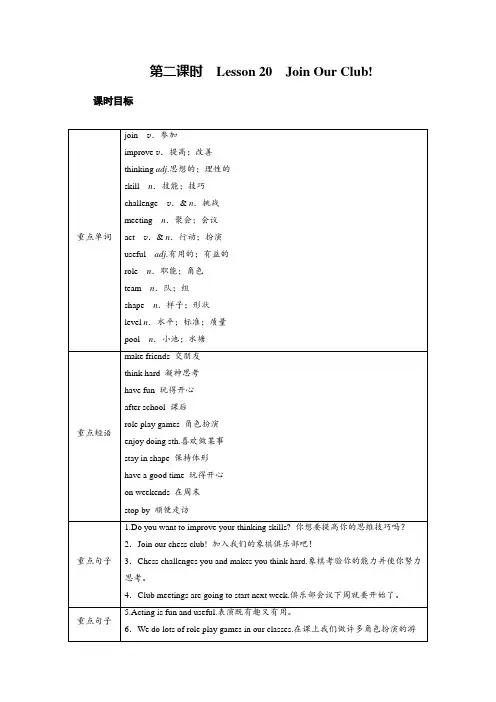
第二课时Lesson 20Join Our Club! 课时目标戏。
7.Join us today or stop by the pool to learn more.今天就加入我们或顺便到泳池边来了解更多情况吧。
教学难点了解不同俱乐部的信息;能用英语描述自己所在的或想加入的俱乐部自主学习一、根据句意及首字母提示写出单词。
1.Are you interested in drawing pictures? Come and join us!2.If you don't know how to improve your thinking skill, we can help you.3.Why are you late for the important meeting?4.I think doing exercises is useful for you.5.We are a good team, though we are at different levels.二、写出下列画线短语的汉语意思。
1.Chess challenges you and makes you think hard.努力思考;凝神思考2.We do lots of role play games in our classes.许多,大量;角色扮演3.Join us today or stop by the pool to learn more.顺便到……来教学过程环节1新课导入教师展示几张与俱乐部有关的图片,然后提问并让学生思考,然后和同桌一起讨论自己参加的俱乐部。
T:What clubs are they, do you know? Now, you can have a discussion with your partners.S1:In Picture 1, it's a camping club.I join the camping club in our school, and you?S2:No, I am not in this club.I am in the chess club now....T:OK! Today we will know more about clubs.设计意图:以图片导入话题,使课堂更具趣味性;通过让学生讨论不同的俱乐部,调动学生参与课堂的积极性,活跃课堂氛围,从而循序渐进地引入本课时的话题,为接下来的学习做好铺垫。
英语四年级下-Module4-unit2-教案
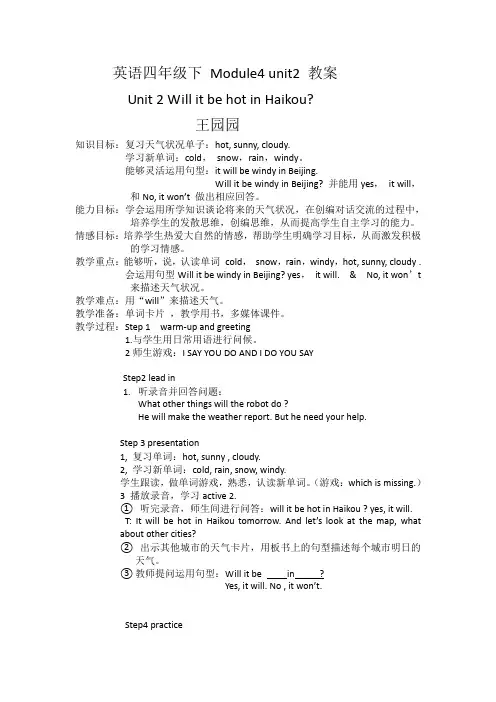
英语四年级下Module4 unit2 教案Unit 2 Will it be hot in Haikou?王园园知识目标:复习天气状况单子:hot, sunny, cloudy.学习新单词:cold,snow,rain,windy。
能够灵活运用句型:it will be windy in Beijing.Will it be windy in Beijing? 并能用yes,it will,和No, it won’t 做出相应回答。
能力目标:学会运用所学知识谈论将来的天气状况,在创编对话交流的过程中,培养学生的发散思维,创编思维,从而提高学生自主学习的能力。
情感目标:培养学生热爱大自然的情感,帮助学生明确学习目标,从而激发积极的学习情感。
教学重点:能够听,说,认读单词cold,snow,rain,windy,hot, sunny, cloudy .会运用句型Will it be windy in Beijing? yes,it will. & No, it won’t来描述天气状况。
教学难点:用“will”来描述天气。
教学准备:单词卡片,教学用书,多媒体课件。
教学过程:Step 1 warm-up and greeting1.与学生用日常用语进行问候。
2师生游戏:I SAY YOU DO AND I DO YOU SAYStep2 lead in1.听录音并回答问题:What other things will the robot do ?He will make the weather report. But he need your help.Step 3 presentation1, 复习单词:hot, sunny , cloudy.2, 学习新单词:cold, rain, snow, windy.学生跟读,做单词游戏,熟悉,认读新单词。
(游戏:which is missing.)3 播放录音,学习active 2.①听完录音,师生间进行问答:will it be hot in Haikou ? yes, it will.T: It will be hot in Haikou tomorrow. And let’s look at the map, whatabout other cities?②出示其他城市的天气卡片,用板书上的句型描述每个城市明日的天气。
五年级上册英语教案-Module 4 Unit 2 What's the matter with D
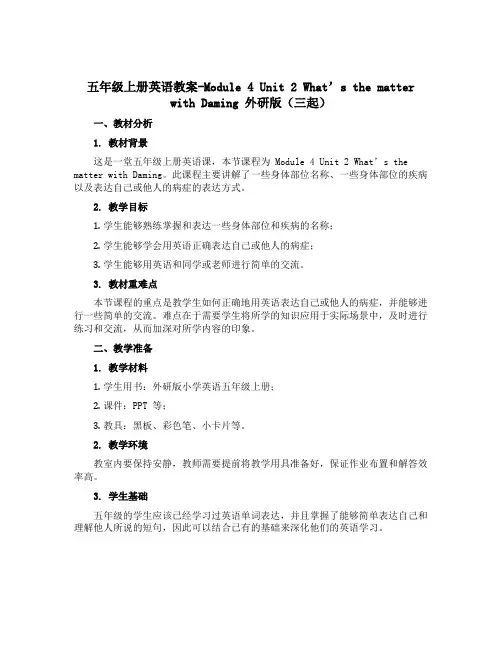
五年级上册英语教案-Module 4 Unit 2 What’s the matterwith Daming 外研版(三起)一、教材分析1. 教材背景这是一堂五年级上册英语课,本节课程为Module 4 Unit 2 What’s the matter with Daming。
此课程主要讲解了一些身体部位名称、一些身体部位的疾病以及表达自己或他人的病症的表达方式。
2. 教学目标1.学生能够熟练掌握和表达一些身体部位和疾病的名称;2.学生能够学会用英语正确表达自己或他人的病症;3.学生能够用英语和同学或老师进行简单的交流。
3. 教材重难点本节课程的重点是教学生如何正确地用英语表达自己或他人的病症,并能够进行一些简单的交流。
难点在于需要学生将所学的知识应用于实际场景中,及时进行练习和交流,从而加深对所学内容的印象。
二、教学准备1. 教学材料1.学生用书:外研版小学英语五年级上册;2.课件:PPT 等;3.教具:黑板、彩色笔、小卡片等。
2. 教学环境教室内要保持安静,教师需要提前将教学用具准备好,保证作业布置和解答效率高。
3. 学生基础五年级的学生应该已经学习过英语单词表达,并且掌握了能够简单表达自己和理解他人所说的短句,因此可以结合已有的基础来深化他们的英语学习。
三、教学过程1. Warm-up教师向学生介绍学习的主题,并通过问候方式了解学生的身体状况,让学生用英语回答问题。
2. Presentation1.教师介绍认识新的单词和短语表达的方法,并帮助学生记住这些单词;2.老师让学生注视图片,并听老师的读音,同时要求学生回忆图片中有哪些人,哪些身体部位出现了问题,以及可能的原因。
3. Practice1.学生跟读教师演示的短语、句子;2.学生尝试用英语来表达自己的身体状况;3.学生进行两两合作,模拟咨询病情,帮助彼此更好地掌握病症表述方式。
4. Production在完成以上练习之后,老师要求学生完成以下作业:1.练习写一篇对话,让学生用自己学过的知识表达自己或他人的身体状况;2.让学生在下堂课前准备一段短文,介绍自己或他人在过去一年中经历的身体问题。
牛津上海版八年级下册英语Unit4 Lesson2 复习教案
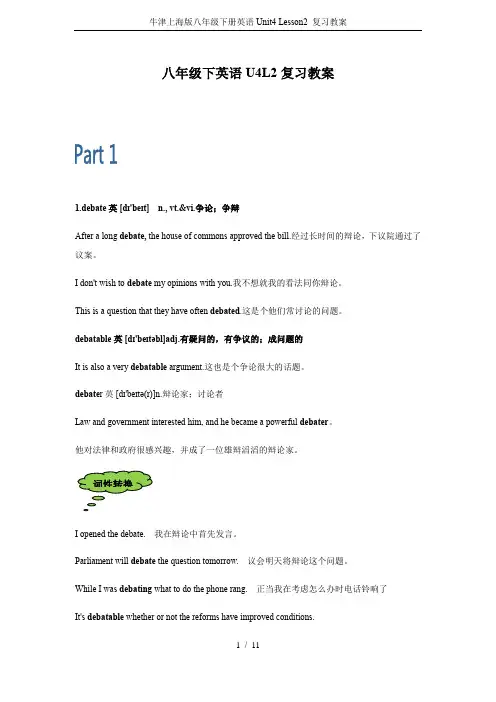
牛津上海版八年级下册英语 Unit4 Lesson2 复习教案八年级下英语 U4L2 复习教案1.debate 英 [dɪ'beɪt] n., vt.&vi.争论;争辩 After a long debate, the house of commons approved the bill.经过长时间的辩论,下议院通过了 议案。
I don't wish to debate my opinions with you.我不想就我的看法同你辩论。
This is a question that they have often debated.这是个他们常讨论的问题。
debatable 英 [dɪ'beɪtəbl]adj.有疑问的,有争议的;成问题的 It is also a very debatable argument.这也是个争论很大的话题。
debater 英 [dɪ'beɪtə(r)]n.辩论家;讨论者 Law and government interested him, and he became a powerful debater。
他对法律和政府很感兴趣,并成了一位雄辩滔滔的辩论家。
词性转换I opened the debate. 我在辩论中首先发言。
Parliament will debate the question tomorrow. 议会明天将辩论这个问题。
While I was debating what to do the phone rang. 正当我在考虑怎么办时电话铃响了 It's debatable whether or not the reforms have improved conditions.1 / 11牛津上海版八年级下册英语 Unit4 Lesson2 复习教案改革是否改善了现状,这问题仍有争议。
A debater's highest criterion is reasoning.衡量辩论家的最高标准是推理能力。
五年级上册英语教案-Unit 4 Feelings Lesson 2|人教(新起点)
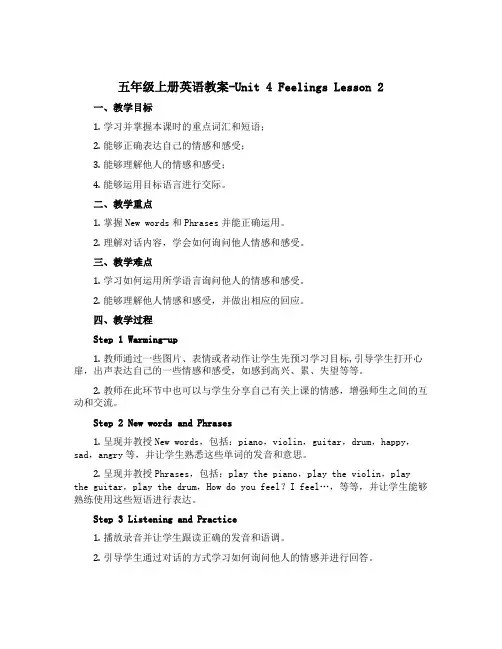
五年级上册英语教案-Unit 4 Feelings Lesson 2一、教学目标1.学习并掌握本课时的重点词汇和短语;2.能够正确表达自己的情感和感受;3.能够理解他人的情感和感受;4.能够运用目标语言进行交际。
二、教学重点1.掌握New words和Phrases并能正确运用。
2.理解对话内容,学会如何询问他人情感和感受。
三、教学难点1.学习如何运用所学语言询问他人的情感和感受。
2.能够理解他人情感和感受,并做出相应的回应。
四、教学过程Step 1 Warming-up1.教师通过一些图片、表情或者动作让学生先预习学习目标,引导学生打开心扉,出声表达自己的一些情感和感受,如感到高兴、累、失望等等。
2.教师在此环节中也可以与学生分享自己有关上课的情感,增强师生之间的互动和交流。
Step 2 New words and Phrases1.呈现并教授New words,包括:piano,violin,guitar,drum,happy,sad,angry等,并让学生熟悉这些单词的发音和意思。
2.呈现并教授Phrases,包括:play the piano,play the violin,play the guitar,play the drum,How do you feel?I feel…,等等,并让学生能够熟练使用这些短语进行表达。
Step 3 Listening and Practice1.播放录音并让学生跟读正确的发音和语调。
2.引导学生通过对话的方式学习如何询问他人的情感并进行回答。
3.教师可以设置一些对话情境(如询问他人对某件事情的感受,或询问他人一天过得怎么样等),鼓励学生在对话中使用所学语言进行交流。
Step 4 Speak up1.学生们分组进行对话练习,将所学知识用于实际表达。
2.学生们进行反馈和互动,互相评价对方的表现,并对自己的表演进行总结和改进。
Step 5 Summary1.教师进行本节课的总结和归纳,向学生强调所学知识和技能的重要性和实用性。
人教版九年级英语上册教案Unit 4 第2课时
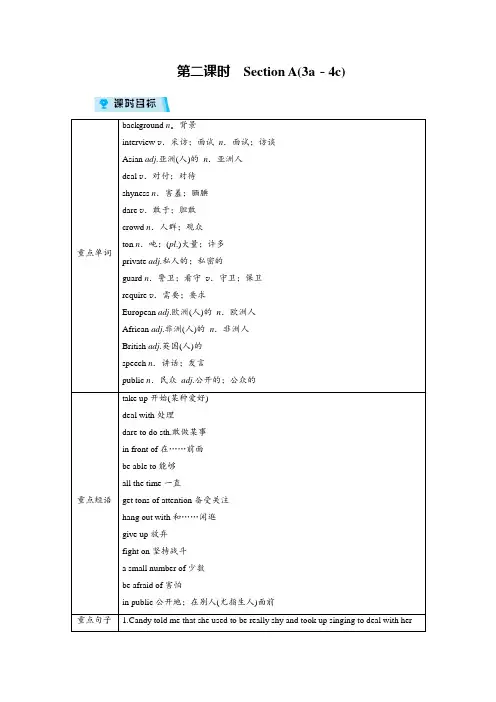
第二课时Section A(3a-4c)重点单词background n.背景interview v.采访;面试n.面试;访谈Asian adj.亚洲(人)的n.亚洲人deal v.对付;对待shyness n.害羞;腼腆dare v.敢于;胆敢crowd n.人群;观众ton n.吨;(pl.)大量;许多private adj.私人的;私密的guard n.警卫;看守v.守卫;保卫require v.需要;要求European adj.欧洲(人)的n.欧洲人African adj.非洲(人)的n.非洲人British adj.英国(人)的speech n.讲话;发言public n.民众adj.公开的;公众的重点短语take up开始(某种爱好)deal with处理dare to do sth.敢做某事in front of在……前面be able to能够all the time一直get tons of attention备受关注hang out with和……闲逛give up放弃fight on坚持战斗a small number of少数be afraid of害怕in public公开地;在别人(尤指生人)面前重点句子 1.Candy told me that she used to be really shy and took up singing to deal with hershyness.坎迪告诉我她过去很害羞,于是她开始唱歌,以克服她的羞怯心理。
2.Now she's not shy anymore and loves singing in front of crowds.现在她不再害羞并且喜欢在众人面前唱歌。
3.I didn't use to be popular in school,but now I get tons of attention everywhere I go.我过去在学校并不受欢迎,但是现在无论我去哪儿都备受关注。
【教案】Unit 4 Learning about Language 人教版选择性必修第二册)
Unit 4 Period 2 Learning about Language 教学设计This section guides students to pay attention to the typical context of vocabulary use, helps students accumulate vocabulary around the key vocabulary of this unit, and uses the learned words and word chunks in different contexts to deeply understand their meaning and usage, so as to achieve the purpose of review and consolidation.The teaching design activities aim to guide students to pay attention to the typical context in which the target vocabulary is used, as well as the common vocabulary used in collocation, so that students can complete the sentence with correct words. In terms of vocabulary learning strategies, this unit focuses on cultivating students' ability to pay attention to collocation of words and to use word blocks to express meaning.For vocabulary learning, it is not enough just to know the meaning of a single word, but the most important thing is to master the common collocations of words, namely word blocks.Teachers should timely guide students to summarize common vocabulary collocation, such as verb and noun collocation, verb and preposition collocation, preposition and noun collocation, and so on.1. Guide students to understand and consolidate the meaning and usage of the vocabulary in thecontext,2. Guide the students to use the unit topic vocabulary in a richer context3. Let the students sort out and accumulate the accumulated vocabulary, establishes the semanticconnection between the vocabulary,4. Enable students to understand and master the vocabulary more effectivelyGuiding the Ss to use unit topic words and the sentence patterns in a richer context.Step1: Complete Samuel's story with the correct phrases.bound for commercial world a massive amount of money urbanareas1. In Canada, _____________________has been spent on preserving the forest, and the country'sdeforestation rate is among the world's lowest.2 .A growing number of woodworkers have decided to move to the ____________________for better jobs.3. Aboard the plane ________________Toronto, Samuel, a young woodworker, began imagining a whole new life in the big city.4. However, he also had some worries. Ideally, he wanted to make a living in the arts, but he also knew well that it was somewhat a _________________________.keys:1. a massive amount of money2.urban areas3.bound formercial worldStep2: Complete the sentence according to the Chinese meanings and the initial letters.1. It's freezing (冰冻的) here—can't we shut a few windows?2.Only in the southern part of Beijing have I seen such scenery (风景) as this.3.That question that we were worried about arose (出现).4.It's always pleasant (令人愉快的) to do what you're good at doing.5.He had left a huge bunch (束) of flowers in her hotel room.6.It's small and red with narrow steps in front and windows so small that you'd think they were holding their breath (呼吸).7.200 peace activists are planning to set up a peace camp at the border (边界).8.One of the highlights (最精彩的部分) of the trip was seeing the Taj Mahal.9.The ships in this small harbor/harbour (港口)are safe.10.With their volcanoes ,valleys and waterfalls , the islands of Hawaii have some of the most spectacular (壮观的)views on earth.Step 3: Complete the sentences using suitable nouns in their correct forms and circle the words which collocate with them.1. After arising in the morning, the first thing he does is to draw the______________.2.He was impressed by her ___________________and charm.3. The visitors were admiring the ______________dating back to the 17th century.4 .We all remember the _____________________of the trip-visiting the Huangguoshu Waterfall.5.Protect the _________________which are unique to Australia and their natural habitats.6. What ___________did you fly?7. It is one of the most difficult _________________to climb in the Rocky Mountains.8. The beauty of Qinghai Lake took t he visitors’ ____________away.9. In freezing cold winter, windows are often covered with_________________.10. We sailed into a beautiful __________________in the southwest of Canada.11. Judy enrolled in a programme of study that was eight months in_______________,but she completed it in only six months.keys:1.curtains2. beauty3. antique4. highlight5.creatures6. airline7. peaks8.breath9.frost 10. bay 11.durationStep4: Suppose you were talking to your friend Jane. Choose the suitable adjectives to comment on the situations.1.Jane: The welcome party at the University of Oxford helped many students to make new friends. You: They must have spent a(n)______________evening together.2 Jane: We’re surprised to find hat is warmer than usual this winter in London.You: You're so lucky to have a ______________winter here.3.Jane:We visited a famous tourist site in Scotland: the beautiful coastline and breathtaking landscape of St Andrews.You: How wonderful! You must have had an _________experience.keys:1.pleasant 2. mild 3. awesomeStep 5:Dictate the key words and phrases in this unit.Part 1: key words:1.adj. 令人愉快的;友好的2.vi. 起身;出现;由……引起3.adj.巨大的;非常严重的4.n.呼吸的空气5.adv.字面上;真正地6.adj.准备前往(某地);一定会7.n.风景;景色8.adj.令人惊叹的;可怕的;很好的9.n.最好或最精彩的部分vt. 突出;强调;使醒目10.vi.& vt. 钻(孔);打(眼) n. 钻(头);训练;演习11.vi.& vt.结冰;(使)冻住12.vt.预料;预见;期望13.n.束;串;捆14.n.窗帘15.n.国界;边界(地区)16.n.手艺;工艺;技艺17.n.古物;古董adj.古老的;古董的18.adj.壮观的;壮丽的;惊人的n.壮丽的场面;精彩的表演19.n.顶峰;山峰;尖形keys:1.pleasant 2. arise 3.massive 4. breath 5.literally 6.bound 7. scenery 8. awesome 9. highlight 10.drill 11. freeze 12. anticipate 13. bunch 14. curtain 15. border 16. craft 17. antique 18. spectacular 19. peakPart 2: Key phrases1.travel by commercial line,take the train to ...乘商业线,乘火车到…2.passing through...通过……3.take a taxi to ...,乘出租车到…4.take a coach bound...through...to...乘长途汽车去……经过……到……5.the train arrived at the station火车到达了车站6.catch the train towards...赶上了开往……的火车7.the train headed ...火车开往…8.the train thundered on ...火车隆隆地前进。
二年级上册英语教案-Unit4第2课时∣人教新起点
二年级上册英语教案Unit4第2课时∣人教新起点教学内容本节课是二年级上册英语《人教新起点》Unit4的第2课时。
教学内容主要围绕“家庭成员”这一主题展开,包括学习家庭成员的英语表达,如“father”、“mother”、“brother”、“sister”等,并通过相关的活动,让学生能够在实际情景中正确运用这些词汇。
教学目标1. 知识目标:学生能够听懂、会说、会读本节课的重点词汇,并能准确拼写。
2. 能力目标:通过本节课的学习,学生能够运用所学词汇简单描述自己的家庭成员,并能进行简单的对话交流。
3. 情感目标:培养学生对家庭的热爱,增强家庭观念。
教学难点1. 词汇记忆:本节课的重点词汇较多,学生需要通过反复练习和记忆来掌握。
2. 句型运用:如何引导学生将所学词汇运用到实际情景中,进行简单的对话交流。
教具学具准备1. 教具:多媒体教学设备,PPT课件,录音机,单词卡片。
2. 学具:学生自备英语课本,练习本,彩色笔。
教学过程1. 导入:利用PPT展示不同家庭成员的图片,引导学生说出对应的中文词汇,进而导入本节课的学习内容。
2. 新授:通过多媒体教学设备播放单词录音,让学生跟读并学习单词的正确发音。
然后,教师通过讲解和示例,让学生理解单词的意思,并能准确运用。
3. 练习:通过游戏、小组活动等形式,让学生反复练习本节课的词汇和句型,巩固所学知识。
4. 展示:邀请学生上台展示自己的学习成果,进行角色扮演或简单对话。
板书设计1. Unit4 My Family2. 重点词汇:father, mother, brother, sister3. 句型:This is my father/mother/brother/sister.作业设计1. 书面作业:完成练习册上的相关练习,巩固所学词汇和句型。
2. 口头作业:回家后,用英语向家长介绍自己的家庭成员。
课后反思本节课通过多媒体教学设备、游戏、小组活动等多种形式,激发了学生的学习兴趣,提高了他们的参与度。
五年级上册英语教学设计-Unit 4 Feelings Lesson 2|人教(新起点)
五年级上册英语教学设计-Unit 4 Feelings Lesson 2|人教(新起点)一、教学目标语言技能目标1.学会运用情感词汇表达自己的情感。
2.学会听、说、读、写表示情感的单词和短语。
3.学会听懂、阅读、理解涉及情感的简短对话。
学习策略目标1.学会课前预习,关注生活中的情感。
2.学会在阅读或听取中发现对自己有用的信息。
3.学会在表达情感时合理地使用语言学习策略。
情感态度目标1.建立自信的情感表达能力。
2.培养情感共鸣情感,关注他人情感。
3.探索和感受不同的情感文化。
二、教学重点1.运用情感词汇表达情感。
2.听懂、理解涉及情感的简短对话。
三、教学难点1.表达自己的情感需要更加细腻和准确的语言。
2.发现并理解对方情感并相应地回应。
四、学情分析1.学生文化背景不同,不同国家不同地区的情感文化有所差别。
2.学生的语言表达能力和接受能力各不相同,有些学生可能需要通过实际情境的演练才能更加深刻地理解情感表达。
五、教学设计1. Warm-up(5 分钟)让学生在班级内自由交流,分享在家庭和社交场合中遇到的情感问题和解决方法。
2. Presentation(10 分钟)1.师生互动,通过发问的方式导入情感单词,让学生尽可能多地说出自己知道的情感单词。
2.运用图片、表情包等多媒体形式,直观地表现情感,帮助学生理解和记忆单词。
3. Practice(30 分钟)1.给学生一些简单的情境,引导他们学会用单词和短语表达相应的情感,例如:玩具丢了,看到喜欢的零食,遇到危险等。
2.通过学生自己编写小对话的方式,锻炼他们查字典、挖掘词义的能力,并帮助他们理解表达情感时文化背景的影响。
3.多种表达方式的实践:学生可以根据情况选择不同的表达方式,让学生在实践中理解细节的含义。
4. Production(15 分钟)1.给学生一个简单的情境和人物,让学生运用所学情感单词进行创作,如:如果你是王明,他的小狗刚刚去世了,如何表达他的悲伤和思念。
四年级英语上册Unit4第2课时Let'slearnLet’sdo教案人教
Unit4 My home第二课时(Let's learn Let’s do)教学目标1. 能听、说、认读单词和词组:bedroom,study,living room,kitchen,bathroom。
2. 能够熟练运用句型:Where's Amy? Is she in the study? Yes, she is. 进行询问并做出回答。
3. 能听懂Let's do里的指令语并做出正确的动作。
教学重点1. Let's learn 里的单词和句型。
2. 会根据指令做相应的动作。
教学难点能够熟练运用句型:Where's Amy? Is she in the study? Yes, she is. 进行询问并做出回答。
教学准备教师准备本课时相关的单词卡片与图片、录音、课件等。
学生准备自己家房间的照片、四线三格英文本。
教学过程Step 1: Warm-up1. 师生自由对话,活跃课堂气氛。
2. 让学生表演Let's talk 的对话,复习上节课的重点句型。
3. 游戏: 捉迷藏(Hide and seek)教师准备各个房间的图片贴在黑板上,然后蒙住一位学生A的眼睛,让另一个学生B在任意一个房间的图片后面画一个小人,表示该生藏在此房间里。
当学生B画好小人后,让学生A猜他/她在哪里。
若答对了其他学生说: Yes, he/she is. 若没答对,其他学生说: No, he/she isn't. 学生A有三次机会,若都没答对,就问:Where is he/she?其他学生说出答案。
Step 2: Presentation1. 教师拿出自己家的照片,向学生们介绍。
如:This is my kitchen. It's small.边说边指着厨房,让学生跟读单词kitchen,并把kitchen 的图片贴在黑板上,让学生认读。
以此方式教授bedroom,study,living room和bathroom等单词和词组。
- 1、下载文档前请自行甄别文档内容的完整性,平台不提供额外的编辑、内容补充、找答案等附加服务。
- 2、"仅部分预览"的文档,不可在线预览部分如存在完整性等问题,可反馈申请退款(可完整预览的文档不适用该条件!)。
- 3、如文档侵犯您的权益,请联系客服反馈,我们会尽快为您处理(人工客服工作时间:9:00-18:30)。
青岛港湾职业技术学院授课教案编号:第周第次课题Unit 4 Loading and discharging班级10航海一、三、五授课日期2011年9月日星期一目的与要求1. Lead Ss to know the English expression about loading andunloading2. Help the Ss to understand the sentences in listening section.3. Help the Ss to express the relevant expression correctly.重点New Words &Phrases and Expressions难点To get the implied meaning of a statement, conversation and passage. Oral presentation授课方式Lecturing and Classroom Interaction Activities 教具Language lab教学过程设计1.LeadinBackground knowledge about cargo handling 2. Listening practiceExplanation to some language pointsMore practice3. Statement4. Simple questions5. AssignmentMaster the useful expressions;Give a speech according to the give topic教学过程1. lead-inBackground knowledge about loading and unloading 2. listening practice1. Bunker --replenish Heavy lift---heavy cargo2. Check the correct interlock of the stowpieces . Toxic —poisonous overflow —满溢,溢出 Shipping seas---船上浪 lid---盖子 Grain elevator---谷物输送机 scupper —排水孔,泄水孔 Sea-valve---海水阀 absorbent material —吸收剂 Gang---组,群 handsomely —慢又稳的 Tackle —吊钩,锁具 fray---受磨损 Rotation —顺序 sag---下沉 Bilge---污水舱底 athwartship —横向的 Fore and aft —纵向的 bulge---胀 Cargo manifest —货物仓单 transshipment---转船,转运Quantity---amount specification---type 3. Statement 3. Describe the procedures of cargo stowage. a. acquisition of information about cargo to be carried. b. the principles and considerations on navigation safety c. the modification of stowage plan. a. Before loading the cargo, the chief officer should acquire necessaryinformation on the nature, mass and stowage factor of the individual cargo.b. the chief officer will use this information to make out the stowage plan in order to ensure adequate stability at all stages of the voyage.The cargo should be stowed evenly to prevent list and trim.c. During cargo stowing process, if the crew or stevedores find anything improper in the stowage plan, he should report it in time.4. Describe the action to be taken in case of an oil spill on board.The following measures should be taken.First, stop all the relevant operation immediately.Secondly, inform the bridge and give theoil spill alarmThen, all crew members should reach the spot with the appropriate tools and materials and get rid of the oil spill according to their respective duties.If oil spill causes the pollution to the nearby waters, launch lifeboats and carry out the oil clearance operation. Meanwhile, inform the harbor authorities for necessary assistance.3.Simple questions9. What doe s “jettison of cargo” mean?----Throw cargo deliberately for ship’s safety sake.10. What does “compatibility of goods” mean?----It means the cargo of similar nature, or cargo that can be stowed in the same hold without affecting each other.11. What does the abbreviation SWL stand for?----SWL stands for Safe Working Load.12. What does “shifting cargo” mean?----It refers to the cargo which is removed from its original place.13. What does “union purchase” mean?----It means a rig in which a pair of derricks is used in combination, also known as “coupled derricks” or “married falls”(双杆联吊作业)14. What preparations shall be done before loading cargo?----Holds should be cleaned and made ready for use and inspection. Stowage plan should be made also.15. What is the loading capacity of your vessel?----15.000 tons.16. What cargo handling gear and equipment does yourvessel have?----My vessel has deck cranes and derricks.4. AssignmentMaster the useful expressions;What must you wear when you enter an enclosed space?---We must wear breathing apparatus, helmet, safety shoes and safety line. Please list some cargo papers?----Stowage plan, hatch list, bill of loading, cargo manifest.Describe how to ensure a proper stowage for general cargo.Cargo stowage is the most important factor to ensure the safety of the ship and cargo.a) One of the most important responsibilities of the first mate is to make sure that cargo will be properly loaded and stowed. Before loading, the chief officer should acquire necessary information of the individual cargo to make out the cargo plan in order to make sure adequate stability.b) The stevedores should load and stow cargo according to the stowage plan. General cargo should be carefully stowed in case any space lost and all the cargo should be secured properly to prevent cargo shifting.。
